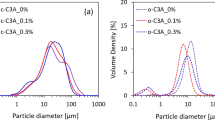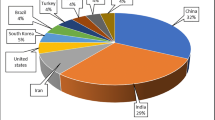Abstract
Assessment of incompatibilities between active pharmaceutical ingredient and pharmaceutical excipients is an important part of preformulation studies. The objective of the work was to assess the effect of moisture content of chitin calcium silicate of two size ranges (two specific surface areas) on the rate of degradation of cefotaxime sodium. The surface area of the excipient was determined using adsorption method. The effect of moisture content of a given size range on the stability of the drug was determined at 40°C in the solid state. The moisture content was determined at the beginning and the end of the kinetic study using TGA. The degradation in solution was studied for comparison. Increasing the moisture content of the excipient of size range 63–180 μm (surface area 7.2 m2/g) from 3.88 to 8.06% increased the rate of degradation of the drug more than two times (from 0.0317 to 0.0718 h−1). While an opposite trend was observed for the excipient of size range < 63 μm (surface area 55.4 m2/g). The rate of degradation at moisture content < 3% was 0.4547 h−1, almost two times higher than that (0.2594 h−1) at moisture content of 8.54%, and the degradation in solid state at both moisture contents was higher than that in solution (0.0871 h−1). In conclusion, the rate of degradation in solid should be studied taking into consideration the specific surface area and moisture content of the excipient at the storage condition and it may be higher than that in solution.




Similar content being viewed by others
References
Harbir K. Processing technologies for pharmaceutical tablets: a review. Int Res J Pharm. 2012;3(7):20–3.
Saha S, Shahiwala AF. Multifunctional coprocessed excipients for improved tabletting performance. Expert Opin Drug Deliv. 2009;6(2):197–208. https://doi.org/10.1517/17425240802708978.
Al-Shaikh Hamid R, Al-Akayleh F, Shubair M, RashidI, Al Remawi M, Badwan A. Evaluation of three chitin metal silicate co-precipitates as a potential multifunctional single excipient in tablet formulations. Mar Drugs. 2010;8(5):1699–715. https://doi.org/10.3390/md8051699.
Rashid I, Daraghmeh N, Al-Remawi M, Leharne SA, Chowdhry BZ, Badwan A. Characterization of chitin–metal silicates as binding superdisintegrants. J Pharm Sci. 2009;98(12):4887–901. https://doi.org/10.1002/jps.21781.
Connors KA, Amidon GL, Stella VJ. Chemical stability of pharmaceuticals: a handbook for pharmacists. 2nd ed. United States: John Wiley & Sons; 1986.
Berge SM, Henderson NL, Frank MJ. Kinetics and mechanism of degradation of cefotaxime sodium in aqueous solution. J Pharm Sci. 1983 Jan;72(1):59–63. https://doi.org/10.1002/jps.2600720114.
Fabre H, Eddine NH, Berge G. Degradation kinetics in aqueous solution of cefotaxime sodium, a third-generation cephalosporin. J Pharm Sci. 1984;73(5):611–8. https://doi.org/10.1002/jps.2600730508.
Cupta V. Stability of cefotaxime sodium as determined by high-performance liquid chromatography. J Pharm Sci. 1984;73(4):565–7.
Lerner DA, Bonnefond G, Fabre H, Mandrou B, Simeon de Buochberg M. Photodegradation paths of cefotaxime. J Pharm Sci. 1988;77(8):699–703. https://doi.org/10.1002/jps.2600770812.
Byrn SR, Xu W, Newman AW. Chemical reactivity in solid-state pharmaceuticals: formulation implications. Adv Drug Deliv Rev. 2001;48(1):115–36. https://doi.org/10.1016/S0169-409X(01)00102-8.
Bharate SS, Bharate SB, Bajaj AN. Interactions and incompatibilities of pharmaceutical excipients with active pharmaceutical ingredients: a comprehensive review. J. Excipients and Food Chem. 2010;1(3):3–26.
Zhou D. Understanding physicochemical properties for pharmaceutical product development and manufacturing II: physical and chemical stability and excipient compatibility. J Val Tech. 2009;15(3):36–47.
Rowe RC, Sheskey PJ, Quinn ME, editors. Handbook of pharmaceutical excipients. 6th ed. United Kingdom: Pharmaceutical press; 2009.
Gana FZ, Rashid I, Badwan A, Alkhamis KA. Determination of solid state acidity of chitin metal silicates and their effect on the degradation of cephalosporin antibiotics. J Pharm Sci. 2012;101(7):2398–407. https://doi.org/10.1002/jps.23142.
Mwesigwa E, Basit AW. An investigation into moisture barrier film coating efficacy and its relevance to drug stability in solid dosage forms. Int J Pharm. 2016;497(1-2):70–7. https://doi.org/10.1016/j.ijpharm.2015.10.068.
Al-Nimry SS, Alkhamis KA, Alzarieni KZ. The effect of specific surface area of chitin metal silicate coprocessed excipient on the chemical decomposition of cefotaxime sodium. J Pharm Sci. 2017;106(2):570–8. https://doi.org/10.1016/j.xphs.2016.10.012.
http://www.sciencecompany.com/Sodium-Silicate-Solution-16oz-P6375.aspx. Accessed 29 September 2017.
Rashid I, Daraghmeh NH, Al Omari MM, Chowdhry BZ, Leharne SA, Hodali HA, et al. Magnesium silicate. In: Brittain HG, editor. Profiles of drug substances, excipients and related methodology. San Diego: Academic press; 2011. p. 241–85.
McClellan AL, Harnsberger HF. Cross-sectional areas of molecules adsorbed on solid surfaces. J Colloid Interface Sci. 1967;23(4):577–99. https://doi.org/10.1016/0021-9797(67)90204-4.
Sinko PJ, Allen LV Jr, Popovich NG, Ansel HC. Martin’s physical pharmacy and pharmaceutical sciences. 5th ed. United States: Lippincott Williams & Wilkins; 2006.
Adamson A, Gast A. Physical chemistry of surfaces. 6th ed. New York: John Wiley and Sons, Inc; 1997.
Lowell S, Shields JE, Thomas MA, Thommes M. Characterization of porous solids and powders: surface area, pore size and density. New York: Springer Science Business Media; 2004.
Vega-Baudrit J, Sibaja-Ballestero M, Vázquez P, Torregrosa-Maciá R, Martín-Martínez JM. Properties of thermoplastic polyurethane adhesives containing nanosilicas with different specific surface area and silanol content. Int J Adhes Adhes. 2007;27(6):469–79. https://doi.org/10.1016/j.ijadhadh.2006.08.001.
Gana FZ. The effect of solid state acidity of chitin metal silicates on the degradation and dissolution of cefotaxime sodium and ketoconazole. MSc dissertation, Irbid, Jordan, Jordan University of Science and Technology; 2011.
Weng HL, Parrott EL. Solid-solid reaction between sulfacetamide and phthalic anhydride. J Pharm Sci. 1984;73(8):1059–63. https://doi.org/10.1002/jps.2600730810.
Acknowledgments
The authors thank the Jordanian Manufacturing Co. (Amman, Jordan) for kindly donating chitin. Also, they thank the deanship of scientific research at Jordan University of Science and Technology for their financial support (grant number 148/2015).
Author information
Authors and Affiliations
Corresponding author
Ethics declarations
Conflict of Interest
The authors declare that they have no conflict of interest.
Rights and permissions
About this article
Cite this article
Al-Nimry, S.S., Alkhamis, K.A. Effect of Moisture Content of Chitin-Calcium Silicate on Rate of Degradation of Cefotaxime Sodium. AAPS PharmSciTech 19, 1337–1343 (2018). https://doi.org/10.1208/s12249-017-0948-1
Received:
Accepted:
Published:
Issue Date:
DOI: https://doi.org/10.1208/s12249-017-0948-1




